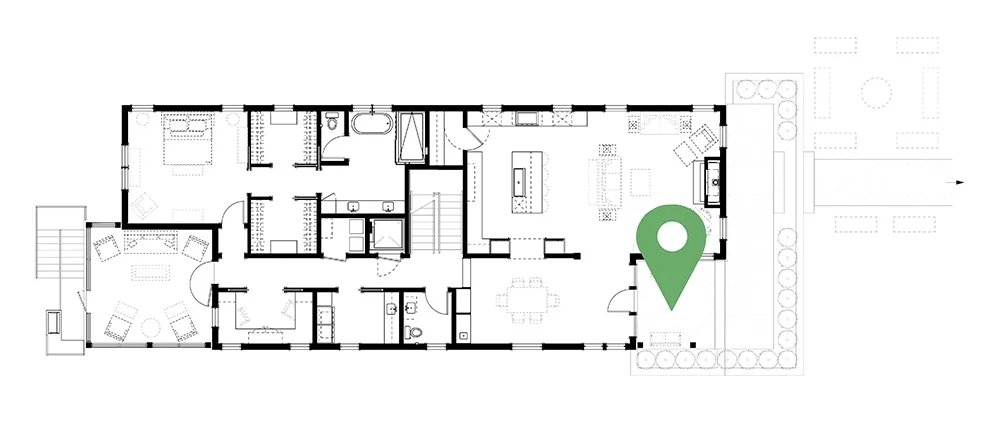GREEN INSPIRATION HOME
Entry Porch & Terrace
Since the Inspiration Home faces south on an extremely narrow lot, the front yard is the only location well suited for fruit trees and gardening. A desire to accommodate food production gracefully drove the planning and design of the entry sequence. A stepped terrace surrounded by an herb bed mitigates the change in grade from the street to the front of the house. The south facing brick walls and pavers absorb heat during the day and release it at night, which provides some protection to the kitchen garden during the winter months.
Three espaliered pomegranate trees in a Belgian fence design soften the brick face of the home, and will offer fruit at an easily accessible height. Potted kumquats flank the entry steps. Several varieties of muscadines are trained along a wooden fence just outside the entry porch, and clusters of fruit trees, tea camellias and berries are closer to the street to easily share with neighbors.
Sheltering the front door, the Entry Porch is perfumed by Bay Laurels, and serves as a perch from which to greet visitors, or pause upon entry and view the bay.
While there is not a homeowners’ association in the bluff neighborhood, we wanted to demonstrate that a front yard could be both attractive and functional for food production. Many homeowners’ associations, in an attempt to protect property values, end up instead encouraging landscapes that require lots of maintenance and provide little value to wildlife or to people. While kitchen gardens are typically rectangular plots on flat ground, they can take the form of edible ground covers, shrubs, vertical vines, flat espaliered trees, and layered groundcover/understory/overstory formations. Tap into your inner hunter/gatherer and get creative!
-
We wanted the Inspiration Home to use materials that would age gracefully over time, gaining character and patina, but still be durable and easy to maintain. We also wanted a material that was of this place, rooted in Alabama. South Alabama Brick company suggested this beautiful “Eutaw Brown” salvaged brick from Selma. Local sourcing greatly reduces the pollution associated with transporting the materials from manufacture to the site, and because the brick is re-used, the energy use and pollution associated with manufacturing are eliminated altogether. As a side benefit, we also support our regional economy.
People tend to think of the environmental impact of a home or building in terms of energy use and utility bills. However, building materials also create significant environmental impacts, through the pollution associated with their extraction, manufacture, and transportation to the job site. This is called “embodied carbon,” with carbon being an indicator of all greenhouse gases, not just carbon dioxide. The environmental impacts of building materials are also front loaded in time, while a building’s energy use creates incremental impacts over a lifetime of use. Since the emissions that we produce between now and 2050 will determine whether or not we avoid the worst impacts of climate change, the embodied carbon of building materials matters a great deal.
For the greatest impact, prioritize the selection of locally produced and sustainably manufactured materials for heavy items that are needed in large quantities, like brick, concrete, framing, or drywall.
-
Manufactured down the road in Foley, AL, the Coppersmith lanterns use electric lighting instead of gas, so that they could be powered by the solar panels. The copper material will weather over time. Materials with that gain character and patina and age connect us to cycles of nature and are a biophilic design strategy.
-
Concrete pavers were sourced from a manufacturer in Foley, to reduce emissions associated with transporting the heavy materials to the job site.



